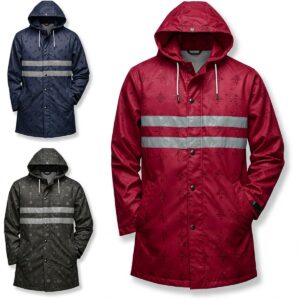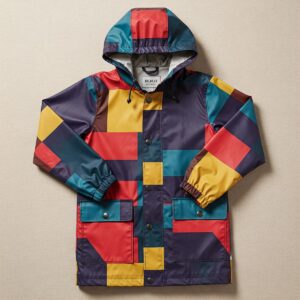Understanding the Raincoat Industrial Pattern Landscape
When it comes to manufacturing high-quality rainwear that can withstand the elements, having the right raincoat industrial pattern is absolutely essential. As someone who has spent years working with textile manufacturers, I’ve seen firsthand how proper pattern development can make or break a production line. The difference between a mediocre raincoat and one that offers superior protection often comes down to the precision of the industrial pattern used during manufacturing.
In today’s competitive market, manufacturers across the USA are constantly seeking ways to improve their rainwear offerings. Furthermore, with unpredictable weather patterns becoming increasingly common, the demand for well-designed, functional raincoats has never been higher. This comprehensive guide will explore everything you need to know about raincoat industrial patterns, from fundamental concepts to advanced techniques that can revolutionize your production process.
✅ Did you know that a properly designed raincoat industrial pattern can reduce material waste by up to 15% during the cutting process?
Whether you’re an established manufacturer looking to refine your existing patterns or a newcomer to the industry seeking to understand the foundations of raincoat production, this guide will provide valuable insights that can help elevate your products to new heights of quality and consumer satisfaction.

Understanding the Basics of Raincoat Industrial Patterns
Before diving into the complexities of raincoat industrial pattern development, it’s crucial to understand what exactly these patterns entail and why they’re so important to the manufacturing process.
What Is a Raincoat Industrial Pattern?
A raincoat industrial pattern is essentially a template used in the mass production of raincoats. Unlike patterns designed for home sewing, industrial patterns are specifically engineered for efficiency, consistency, and scalability in factory settings. These patterns include precise measurements, cutting guides, and assembly instructions that allow manufacturers to produce identical raincoats in various sizes while maintaining quality standards.
The raincoat industrial pattern serves as the foundation for the entire production process. It determines not only the final look of the garment but also crucial functional aspects such as:
- Water resistance capabilities
- Range of motion for the wearer
- Compatibility with automated cutting systems
- Material utilization efficiency
- Production time requirements
✅ Professional raincoat industrial patterns account for shrinkage, material stretch, and seam allowances that might differ from traditional garment patterns.
The Evolution of Raincoat Industrial Patterns
The history of raincoat industrial patterns reflects broader technological advances in the textile industry. Initially, patterns were created entirely by hand, requiring exceptional skill and experience from pattern makers. However, as manufacturing technologies evolved, so too did the approaches to pattern development.
Today’s raincoat industrial pattern development typically involves a blend of traditional craftsmanship and modern digital technologies. Computer-Aided Design (CAD) software has revolutionized the industry, allowing for precision adjustments and rapid modifications that would have been extremely time-consuming in the past.
According to research from the International Journal of Clothing Science and Technology, the adoption of digital pattern-making technologies has reduced development time by approximately 40% compared to traditional methods, while simultaneously improving fit consistency across size ranges.
Key Components of an Effective Raincoat Industrial Pattern
Creating a successful raincoat industrial pattern requires attention to several critical components. Understanding these elements can help manufacturers optimize their production processes and create superior products.
Material Considerations in Pattern Development
One of the most crucial aspects of raincoat industrial pattern design is accounting for the specific materials being used. Unlike everyday clothing patterns, raincoat patterns must accommodate the unique properties of waterproof materials, which often behave differently during cutting, sewing, and wearing.
Different waterproof materials require different approaches to pattern design:
- Woven waterproof fabrics (like traditional raincoat materials) typically have minimal stretch and require precise pattern measurements
- Technical waterproof fabrics with stretch components need adjusted patterns to account for material behavior
- Laminated waterproof materials may require special seam allowances to accommodate sealing techniques
✅ The right raincoat industrial pattern will account for material thickness at seam intersections, which is especially important for waterproof taping processes.
According to the American Association of Textile Chemists and Colorists, proper pattern development that accounts for material properties can extend a raincoat’s functional lifespan by up to 30% by reducing stress on critical seams and wear points.
Ergonomic Considerations in Raincoat Industrial Patterns
While waterproofing is obviously the primary function of a raincoat, wearability is equally important for consumer satisfaction. Modern raincoat industrial pattern development places significant emphasis on ergonomics—the science of designing products that work optimally with the human body.
Key ergonomic considerations in raincoat industrial patterns include:
- Range of motion requirements, particularly in the shoulders and arms
- Hood design that protects while maintaining visibility
- Pocket placement that allows access while maintaining waterproof integrity
- Ventilation features that don’t compromise water resistance
I’ve found that manufacturers who prioritize ergonomics in their raincoat industrial pattern development typically see higher customer satisfaction ratings and fewer returns. This attention to wearability is especially important in performance rainwear designed for outdoor activities.
Advanced Techniques in Raincoat Industrial Pattern Development
As manufacturing technologies continue to evolve, so too do the techniques used to create and implement raincoat industrial patterns. Understanding these advanced approaches can give manufacturers a significant competitive advantage.
3D Modeling and Virtual Prototyping
Perhaps the most transformative development in recent years has been the adoption of 3D modeling software for raincoat industrial pattern development. These sophisticated tools allow pattern makers to visualize garments before cutting a single piece of fabric.
The benefits of 3D modeling for raincoat industrial patterns include:
- Ability to identify potential fit issues before physical prototyping
- Reduced material waste during the development phase
- Faster iteration cycles for pattern refinement
- More accurate visualization of how waterproof materials will drape and perform
Research published in the Journal of Fashion Technology & Textile Engineering indicates that manufacturers implementing 3D modeling technologies reduce their development costs by approximately 25% while bringing products to market an average of 40% faster.
Parametric Pattern Development
Another cutting-edge approach gaining traction in the industry is parametric pattern development. This technique uses algorithms and mathematical formulas to automatically adjust patterns based on input parameters.
For raincoat industrial pattern development, parametric approaches offer significant advantages:
- Instant pattern grading across size ranges with appropriate proportional adjustments
- Ability to quickly adapt designs for different body types while maintaining functional integrity
- Efficient creation of pattern variations for different material properties
✅ Parametric raincoat industrial pattern systems can reduce the time required for size grading by up to 70% compared to traditional methods.
Common Challenges in Raincoat Industrial Pattern Implementation
Even the most meticulously designed raincoat industrial pattern can face implementation challenges in real-world manufacturing environments. Understanding these common obstacles can help manufacturers develop strategies to overcome them.
Material Handling Complications
Waterproof materials used in raincoat production often present unique challenges during cutting and assembly. These materials may be slippery, sensitive to heat, or prone to damage from traditional handling methods.
A well-designed raincoat industrial pattern should include specific instructions for:
- Optimal cutting techniques for different waterproof materials
- Handling guidelines to prevent damage during assembly
- Special markings to indicate areas requiring particular attention
According to a study by the Textile Research Journal, proper material handling protocols specified in pattern documentation can reduce defect rates by up to 35% in waterproof garment production.
Sealing Technique Integration
Unlike standard garments, raincoats require special sealing techniques to maintain waterproof integrity at seams. These techniques—such as heat sealing, taping, and welding—must be carefully integrated into the raincoat industrial pattern development process.
Effective pattern documentation will include:
- Clear indications of seams requiring waterproof sealing
- Specific allowances for different sealing techniques
- Guidelines for sealing equipment settings based on material thickness
✅ Modern raincoat industrial patterns now often include digital markers that can be read by automated sealing equipment, increasing precision and efficiency.
Optimizing Raincoat Industrial Patterns for Production Efficiency
Beyond creating functional, attractive raincoats, industrial patterns must also support efficient manufacturing processes. This aspect of pattern development has significant implications for production costs and competitiveness.
Material Utilization Optimization
One of the most impactful ways a raincoat industrial pattern can affect production costs is through material utilization. Waterproof fabrics are typically more expensive than standard textiles, making efficient cutting layouts crucial for profitability.
Advanced raincoat industrial pattern development includes:
- Nesting optimization for minimal waste during cutting
- Strategic pattern piece shapes that maximize material utilization
- Guidelines for effective marker making across size runs
Studies from the Institute of Textile and Clothing at The Hong Kong Polytechnic University suggest that optimized cutting layouts can reduce material waste by 8-12% compared to standard layouts, representing significant cost savings for manufacturers.
Production Line Compatibility
A truly effective raincoat industrial pattern doesn’t just consider the final product—it also accounts for the specific production environment where it will be implemented. This includes compatibility with the machinery, workflow, and personnel capabilities of the manufacturing facility.
Key considerations include:
- Designing pattern pieces that work with available cutting equipment
- Creating assembly sequences optimized for the factory’s workflow
- Providing notations compatible with the skill level of the workforce
I’ve observed that manufacturers who adapt their raincoat industrial patterns to their specific production environments typically achieve 15-20% higher production efficiency compared to those using generic patterns.

Top-Quality Tools for Raincoat Industrial Pattern Development
Having the right tools can significantly impact the quality and efficiency of raincoat industrial pattern development. Here are some professional-grade options that can elevate your pattern-making capabilities:
Gerber AccuMark Pattern Design Software
One of the industry’s leading pattern design systems, Gerber AccuMark offers comprehensive tools specifically valuable for raincoat industrial pattern development. With specialized functions for technical fabrics and waterproof garments, this software provides exceptional precision and efficiency.
Key features that make it ideal for raincoat patterns include:
- Advanced nesting capabilities to maximize material utilization
- Specialized tools for handling technical fabrics
- Integrated 3D visualization for waterproof garment testing
Wildcat Pattern Digitizing Table
For manufacturers who work with both physical and digital patterns, the Wildcat Pattern Digitizing Table provides an excellent bridge between traditional craftsmanship and modern technology. This high-precision digitizing solution allows pattern makers to convert physical raincoat patterns to digital files with exceptional accuracy.
This tool is particularly valuable for:
- Adapting existing successful raincoat industrial patterns to digital formats
- Capturing the subtle adjustments made during physical prototyping
- Preserving institutional knowledge from experienced pattern makers
Eastman Blue Streak II Pattern Cutting System
When it comes to producing physical pattern pieces for sampling or small-batch production, the Eastman Blue Streak II represents the gold standard. This precision cutting system ensures exact replication of digital patterns into physical form.
Benefits for raincoat pattern development include:
- Precision cutting of thick pattern materials suitable for industrial use
- Ability to create durable patterns that withstand production environments
- Consistent accuracy across multiple pattern pieces
Comparison of Professional Raincoat Pattern Development Tools
| Tool | Best For | Price Range | Learning Curve | Technical Support |
|---|---|---|---|---|
| Gerber AccuMark | Complete digital pattern development | $$$$ | Steep | Excellent |
| Wildcat Digitizing Table | Hybrid physical/digital workflows | $$$ | Moderate | Good |
| Eastman Blue Streak II | Physical pattern production | $$ | Minimal | Limited |
⚡ Upgrade Your Raincoat Production Now! ⚡

Ready to revolutionize your raincoat manufacturing process? The tools above represent industry-leading solutions that can dramatically improve your pattern development capabilities. Click any link to check current pricing and availability—investing in quality pattern development tools typically pays for itself through improved efficiency and reduced material waste!
Quality Assurance in Raincoat Industrial Pattern Implementation
Creating an excellent raincoat industrial pattern is only the first step; ensuring consistent implementation in production environments is equally important. Establishing robust quality assurance protocols specifically for pattern-related aspects of production is essential.
Pattern Validation Processes
Before a raincoat industrial pattern enters full production, it should undergo thorough validation testing to identify any potential issues or opportunities for improvement.
Effective validation processes include:
- Sample production across multiple sizes to verify fit consistency
- Waterproof testing of seams specified in the pattern
- Movement testing to ensure ergonomic goals are met
- Wash testing to confirm pattern accommodates any material shrinkage
According to the American Society for Quality, manufacturers who implement comprehensive pattern validation processes experience 45% fewer quality-related issues during full production runs.
Documentation Standards for Raincoat Industrial Patterns
Clear, comprehensive documentation is a critical component of successful pattern implementation. This is especially true for raincoat production, where special techniques and materials require precise instructions.
✅ Professional raincoat industrial pattern documentation should include:
- Detailed cutting instructions specific to waterproof materials
- Assembly sequence with attention to waterproof integrity
- Sealing specifications for each seam type
- Quality checkpoints throughout the production process
I’ve found that manufacturers who invest in detailed pattern documentation report significantly higher consistency across production runs and reduced training time for new personnel.
Adapting Raincoat Industrial Patterns for Different Market Segments
The rainwear market encompasses diverse consumer needs, from lightweight packable travel raincoats to heavy-duty work wear. Successful manufacturers often adapt their industrial patterns to address these various segments effectively.
Patterns for Performance Rainwear
The outdoor and athletic markets demand raincoats that offer protection while enabling high activity levels. Industrial patterns for this segment require special considerations:
- Articulated sleeves and shoulders for increased range of motion
- Strategic ventilation features that maintain waterproof integrity
- Lightweight construction techniques compatible with technical fabrics
The Outdoor Industry Association reports that the performance rainwear segment is growing at approximately 7% annually, making it an attractive market for manufacturers with the right pattern development capabilities.
Patterns for Fashion-Forward Rainwear
As consumers increasingly view rainwear as a fashion statement rather than purely functional gear, patterns must evolve to incorporate more sophisticated design elements:
- More complex silhouettes that remain compatible with waterproofing requirements
- Integration of fashion details without compromising function
- Accommodation for decorative elements and branding opportunities
✅ Fashion-oriented raincoat industrial patterns typically include more complex cutting layouts but can command premium pricing in the marketplace.
Sustainable Approaches to Raincoat Industrial Pattern Development
Sustainability has become a critical consideration in all aspects of garment manufacturing, including pattern development. For raincoat production, sustainable pattern practices can significantly reduce environmental impact while often improving bottom-line results.
Zero-Waste Pattern Design
Traditional pattern making typically accepts some level of material waste as inevitable. However, innovative approaches to raincoat industrial pattern development are challenging this assumption through zero-waste design principles.
Key techniques include:
- Jigsaw pattern layouts that utilize nearly 100% of fabric width
- Strategic seam placement that serves both functional and waste-reduction purposes
- Pattern pieces designed to utilize typical fabric waste areas
Research published in the Journal of Cleaner Production indicates that zero-waste pattern approaches can reduce material consumption by up to 15% while creating distinctive design aesthetics that appeal to sustainability-conscious consumers.
Longevity-Focused Pattern Development
Perhaps the most sustainable approach to raincoat production is creating garments that last longer through superior design and construction. Industrial patterns can contribute significantly to product longevity through:
- Reinforcement areas built into pattern pieces for high-stress points
- Easily repairable construction methods specified in assembly instructions
- Adjustable features that accommodate changing user needs over time
✅ Patterns designed with longevity in mind often incorporate modular elements that allow for component replacement rather than whole-garment disposal.
Emerging Technologies Impacting Raincoat Industrial Patterns
The future of raincoat industrial pattern development is being shaped by several emerging technologies that promise to further revolutionize the industry. Understanding these innovations can help manufacturers prepare for coming changes.
AI-Driven Pattern Optimization
Artificial intelligence is beginning to transform pattern development through sophisticated optimization algorithms that can analyze vast datasets to identify improvements invisible to human pattern makers.
Potential applications for raincoat industrial patterns include:
- Material utilization optimization beyond human calculation capabilities
- Fit refinement based on 3D body scan databases
- Production efficiency optimization across multiple variables
According to MIT’s Technology Review, AI-optimized patterns can improve material efficiency by an additional 5-8% compared to human-optimized patterns while simultaneously enhancing fit consistency.
Distributed Manufacturing Compatibility
As production models evolve toward more distributed, on-demand manufacturing, raincoat industrial patterns must adapt to support these new paradigms. This includes:
- Digital pattern formats compatible with diverse production environments
- Standardized notation systems that transcend language and training differences
- Modular design approaches that support customization without sacrificing efficiency
✅ Forward-thinking manufacturers are developing “universal” raincoat industrial pattern systems that can be implemented across various production environments without modification.
Professional Development for Raincoat Pattern Specialists
The specialized knowledge required for effective raincoat industrial pattern development necessitates ongoing professional development for pattern makers and production teams. Investing in this expertise can provide significant competitive advantages.
Specialized Training Resources
Several institutions offer specialized training in technical pattern development specifically relevant to rainwear production:
- The Fashion Institute of Technology offers certificate programs in technical design for performance apparel
- NC State University’s College of Textiles provides specialized courses in waterproof garment development
- Gerber Technology University offers rainwear-specific training for their pattern systems
Manufacturers who support continuing education for their pattern development teams typically see improved innovation rates and faster problem-solving capabilities.
Industry Collaboration Opportunities
The specialized nature of raincoat production has fostered several industry collaboration initiatives focused on advancing pattern development techniques:
- The Waterproof Garment Consortium shares research and best practices
- Technical textile trade shows offer workshops on advanced pattern techniques
- Material suppliers often provide specialized training for optimizing patterns for their specific fabrics
I’ve observed that manufacturers who actively participate in these collaborative opportunities often gain early access to innovative techniques that provide competitive advantages.

Custom Raincoat Industrial Pattern Services
For some manufacturers, developing in-house pattern expertise may not be feasible or cost-effective. Fortunately, specialized pattern service providers can fill this gap with customized solutions.
Technical Pattern Partners Professional Services
For manufacturers seeking expert assistance with raincoat industrial pattern development, Technical Pattern Partners offers comprehensive services tailored specifically to waterproof garment production. Their team includes specialists with decades of experience in performance outerwear.
Their raincoat pattern services include:
- Custom pattern development based on your design concepts
- Pattern optimization for your specific production environment
- Complete technical packages with detailed assembly instructions
RainTech Pattern Solutions Software
For companies looking to build internal capabilities, RainTech Pattern Solutions offers specialized software designed specifically for rainwear pattern development. This intuitive system includes raincoat-specific templates and tools that streamline the creation process.
Key advantages include:
- Pre-built raincoat blocks that can be quickly customized
- Special tools for waterproof seam planning
- Material-specific adjustments for common rainwear fabrics
🌧️ Transform Your Raincoat Production Today! 🌧️
Whether you need professional pattern development services or tools to enhance your in-house capabilities, the solutions above can dramatically improve your rainwear products. Click through to explore options that align with your manufacturing goals and budget—professional pattern development is an investment that pays dividends in product quality and production efficiency!
Case Studies: Successful Implementation of Advanced Raincoat Industrial Patterns
Examining real-world examples of successful pattern implementation can provide valuable insights for manufacturers seeking to improve their own processes.
Pacific Northwest Outerwear: Zero-Waste Revolution
A medium-sized rainwear manufacturer based in Oregon implemented zero-waste pattern principles across their production line with remarkable results:
- Material costs reduced by 14% within the first production cycle
- Distinctive aesthetic resulting from innovative seam placements became a brand signature
- Production time decreased by 8% due to simplified cutting processes
The company’s transition required significant upfront investment in pattern development but achieved ROI within nine months through material savings alone.
Metropolitan Essentials: Pattern Digitization Success Story
A New York-based raincoat brand specializing in urban-focused designs transitioned from traditional to fully digital pattern development:
- Development time for new styles decreased from 4 weeks to 10 days
- Pattern modifications for different fabrics became 60% faster
- Size consistency improved measurably, reducing returns by 24%
✅ Their success hinged on comprehensive training for the pattern team and phased implementation that allowed for adjustment during the transition.
Future Trends in Raincoat Industrial Pattern Development
As we look toward the future, several emerging trends are likely to shape raincoat industrial pattern development in significant ways.
Personalization at Scale
Advances in pattern technology are making mass customization increasingly viable for rainwear production. This trend involves:
- Parametric patterns that can adjust to individual body measurements
- Modular design approaches that allow consumers to select specific features
- Digital production methods that reduce the cost of small batch manufacturing
According to McKinsey & Company, personalized apparel represents one of the fastest-growing segments in the industry, with annual growth rates exceeding 20% in some markets.
Integrated Wearable Technology Accommodation
As smart textiles and wearable technology become more prevalent, raincoat industrial patterns must evolve to accommodate these innovations:
- Special channels and pockets for power distribution and sensors
- Reinforced areas for technology connection points
- Strategic seam placement to integrate with smart textile capabilities
✅ Forward-thinking manufacturers are already developing “tech-ready” pattern systems that can easily incorporate wearable technology components as they become available.
Conclusion: Mastering Raincoat Industrial Patterns for Competitive Advantage
Throughout this comprehensive guide, we’ve explored the many facets of raincoat industrial pattern development and implementation. The importance of this specialized knowledge cannot be overstated—in many ways, the pattern is the foundation upon which all other aspects of raincoat manufacturing rest.
Manufacturers who invest in developing their pattern expertise typically see improvements across multiple performance metrics:
- Reduced material costs through efficient pattern layouts
- Improved product quality and consistency
- Faster development cycles for new products
- Enhanced worker productivity through optimized production patterns
For those seeking to elevate their raincoat production capabilities, focusing on pattern development offers one of the highest returns on investment available in the manufacturing process. By implementing the principles and techniques outlined in this guide, manufacturers can position themselves for success in this competitive and evolving market.
🔍 Ready to Elevate Your Rainwear Production? 🔍
The tools and services highlighted in this guide represent the best solutions currently available for raincoat industrial pattern development. Click on any product link to explore detailed specifications and current pricing—investing in professional pattern development resources is the first step toward manufacturing excellence!

More FAQs:
❓ What materials are commonly used in industrial raincoat patterns?
✅ Industrial raincoat patterns often feature PVC, polyester, or nylon fabrics for their strength, water resistance, and long-lasting performance…
❓ How does seam sealing improve industrial raincoat durability?
✅ Seam sealing blocks water from seeping through stitched areas, helping the raincoat remain fully waterproof in demanding environments…
❓ Why are synthetic fabrics favored in industrial raincoat designs?
✅ Synthetic materials like PVC and nylon resist tearing and moisture, making them ideal for industrial raincoats exposed to harsh conditions…
❓ What features define an effective industrial raincoat pattern?
✅ Essential features include reinforced seams, adjustable hoods, and vented panels that enhance comfort while maintaining weather protection…
❓ How is an industrial raincoat pattern different from a regular raincoat?
✅ Industrial raincoat patterns focus on safety, durability, and function, often including high-visibility colors and resistance to chemicals…
Recommended for You:
- 7 Best Raincoat Factor Pattern Options for Ultimate Weather Protection in 2025
- 10 Best Rain Jacket Plus Size Options for All-Weather Protection in 2025
- 10 Best Police Raincoats for Ultimate Weather Protection in 2025
Disclaimer: This article contains affiliate links. If you purchase products through these links, we may earn a small commission at no additional cost to you.

